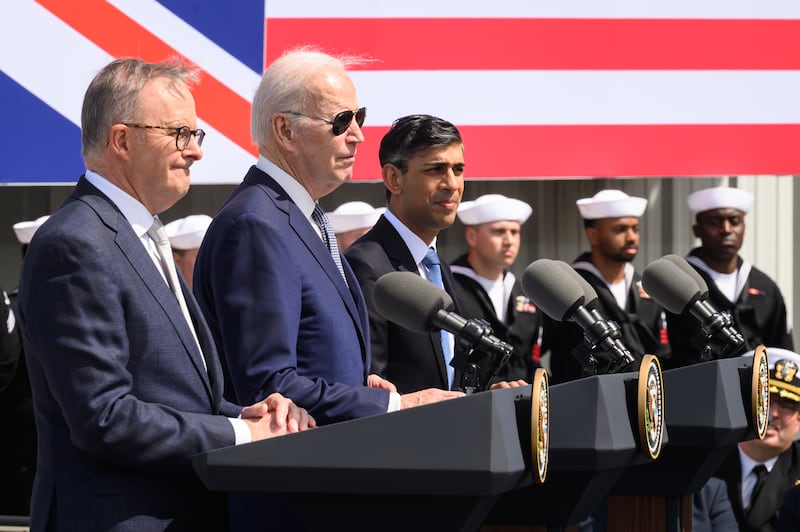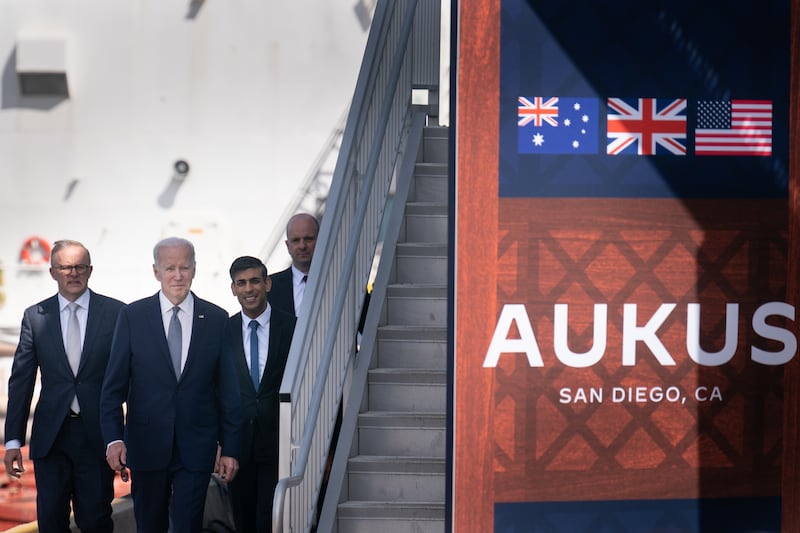The US, UK and Australia have unveiled a decades-long project to supply Canberra with nuclear-powered submarines, entering a historic partnership that binds the allies more tightly as they counter China in the Indo-Pacific.
US president Joe Biden, Australia’s prime minister Anthony Albanese and UK prime minister Rishi Sunak met in San Diego, California, on Monday to unveil the parameters of the submarine programme, with the USS Missouri, a Virginia-class submarine, in the background.
“For more than a century, our three nations have stood shoulder to shoulder ... to help sustain peace, stability, and prosperity around the world, including in the Indo-Pacific,” the three leaders said in a joint statement. “The steps we are announcing today will help us to advance these mutually beneficial objectives in the decades ahead.”
Speaking alongside his Australian and British counterparts at Naval Base Point Loma, Mr Biden said: “Aukus has one overriding objective – to enhance the stability in the Indo-Pacific amid rapidly shifting global dynamics”.
READ MORE
Mr Albanese said the security pact marked a “new chapter” in relations between the three allies. “Aukus ... represents the biggest single investment in Australia’s defence capability in all our history, strengthening Australia’s national security and stability in our region.”
Mr Sunak said the growing assertiveness of countries from China and North Korea to Iran, in addition to Russia’s invasion of Ukraine, all threatened to “create a world defined by danger, disorder and division”.
[ US was ‘clumsy’ in Aukus submarine deal, Biden admits to MacronOpens in new window ]
“For the first time ever, it will mean three fleets of submarines working together across both the Atlantic and Pacific,” Mr Sunak added.
The announcement followed 18 months of talks since the allies signed the trilateral Aukus security pact in September 2021, laying out co-operation on some of the US’s most closely guarded military technologies.

Under the three-stage plan, Australia and Britain will co-build a new submarine – dubbed the SSN Aukus – based on a modified version of a next-generation boat the UK was already in the process of designing.
The UK and Australia each plan to build at least eight of the multibillion-dollar submarines. The first Australian boats will not enter service until the early 2040s, with the full fleets being built over the following two decades.
Some UK defence chiefs have signalled that Britain would be open to expanding its fleet of submarines to as many as 19 in the future.
[ Australia’s pact with the UK and US worries its neighboursOpens in new window ]
US national security adviser Jake Sullivan said America’s willingness to share its “crown jewels” – nuclear propulsion technology – with Australia as part of the pact underscored the importance Mr Biden placed on allies.
“If Ronald Reagan’s formula was ‘peace through strength’, Joe Biden’s formula is ‘peace through American and allied strength’,” Mr Sullivan said.
“President Biden has talked often and feels very strongly about ... connecting our allies in the Atlantic with our allies in the Pacific,” he added. “That is Aukus at its heart.”
Australia wants to replace its diesel-powered Collins-class submarines with nuclear-powered boats, which are stealthier and can travel farther. The submarines will carry non-nuclear conventional weapons.

The US and UK will help Australia bridge the gap that will emerge as the Collins-class submarines start to retire in the 2030s.
US officials said the first phase would involve the US Navy deploying four Virginia-class submarines to Perth, Australia, starting in 2027. The UK will send an Astute-class submarine a couple of years later. Mr Sullivan said the USS Asheville, a Los Angeles-class submarine, was already in Perth.
Once Australia has developed a cadre of sailors, the US will sell Canberra between three and five Virginia-class submarines through a combination of new and refurbished boats. The goal for the first procurement is 2032.
Australia will also invest in the US and UK’s defence industrial base, an unprecedented move aimed at boosting manufacturing capacity at strained shipyards. “To the extent that Aukus places additional requirements on that industrial base, the Australians are picking up the bill,” said Mr Sullivan.
Aukus, which includes a second pillar that involves co-operation in areas ranging from hypersonic weapons to quantum computing, will bolster allied co-operation and boost deterrence against China.
[ Janan Ganesh: Biden’s French snub a warning to EuropeOpens in new window ]
Charles Edel, an Australia expert at CSIS, a think-tank, said the “animating” push behind Aukus was China’s rapidly expanding military power and increasingly aggressive use of force. He added that the security pact was “a harbinger of where American and allied strategy is heading”.
China on Tuesday warned that Aukus would start an arms race and undermine the international nuclear weapon non-proliferation treaty through the transfer of what it said was “weapons-grade” highly enriched uranium to a non-nuclear weapon state.
“The three countries have gone further and further down the wrong and dangerous path for their own geopolitical self-interest, completely ignoring the concerns of the international community,” China’s foreign ministry spokesperson said.
One senior US official rejected suggestions the US wanted to “contain” China, saying Aukus was an effort to “defend and secure” the Indo-Pacific, particularly after “provocative steps” under Chinese president Xi Jinping.
The three-stage Aukus plan:
Phase 1
• The US and UK will train Australian sailors and engineers to operate nuclear-powered submarines.
• The US will deploy four Virginia-class boats to HMAS Stirling, a naval port near Perth, over four years, starting in 2027. Britain will deploy one Astute-class submarine several years later.
• Submarines will be deployed to what the three allies are calling “Submarine Rotational Force West”.
• Australia will start constructing submarine shipbuilding yard infrastructure and maintenance facilities in Adelaide. It will also invest in US and UK shipbuilding industries to help the countries tackle production constraints.
Phase 2
• The US will sell between three and five Virginia-class submarines to Australia, starting in 2032.
• Submarines will be manned by Australian sailors, who will have been trained to operate the nuclear-powered boats, but could include “riders” from the US and UK.
Phase 3
• Australia and the UK will start building the SSN Aukus, which will be a modified version of the next-generation SSN(R) submarine that Britain was already designing. The first boats are not expected to enter service for two decades. Fuel for the reactors will be provided by the US, but Australia will take care of nuclear waste, including spent fuel.
• The two countries will co-build the submarines, but Britain may have a bigger share of the production in the early years while Australia builds out its manufacturing facilities. However, the majority of the Australian boats will be produced in Australia, according to one US official. – Copyright The Financial Times Limited 2023













